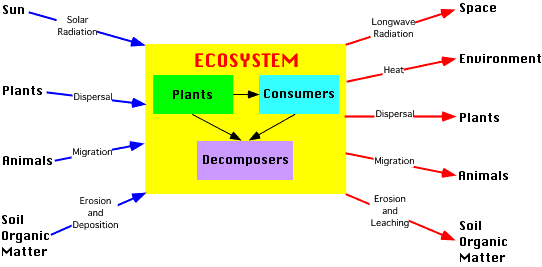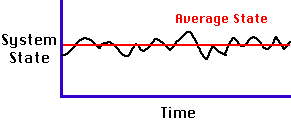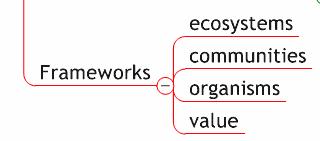Saturday, September 03, 2005
thoughts on the book
from bob's work... i must help the reader by making the backbone of the book clear.
also, what does the reader want? access to what to do is part of it were i the reader, i'd want:
- immediately accessible subject matter
- ability to skim and get it
- logical flow or narrative i can plant in my head
- visual as well as written content
- learning model and model of ecosystem
- ecosystem=optimize this unit complexity
- garden=organization seasons, harmony
- tree=individuals lifecycle
borrow from nature...
small pieces loosely joined?
reflection: time for this and schmooze being eaten by blackberry. out of balance.
rely on people to do the right thing: village behavior takes a village
prototypicle chapter
- visual language & verbal topic
- story/case
- observations
- commentary from salons
- takeaway
- profile of exemplar

The Earth's biosphere is made up small interacting entities called ecosystems. In an ecosystem, populations of species group together into communities and interact with each other and the abiotic environment. The smallest lining entity in an ecosystem is a single organism. An organism is alive and functioning because it is a biological system. The elements of a biological system consist of cells and larger structures known as organs that work together to produce life. The functioning of cells in any biological system is dependent on numerous chemical reactions. Together these chemical reactions make up a chemical system. The types of chemical interactions found in chemical systems are dependent on the atomic structure of the reacting matter. The components of atomic structure can be described as an atomic system.
the food chain
Equilibrium
Equilibrium describes the average condition of a system, as measured through one of its elements or attributes, over a specific period of time. For the purposes of this online textbook, there are six types of equilibrium:
(1) Steady state equilibrium is an average condition of a system where the trajectory remains unchanged in time.

Feedbacks
In order for a system to maintain a steady state or average condition the system must possess the capacity for self-regulation. Self-regulation in many systems is controlled by negative feedback and positive feedback mechanisms. Negative-feedback mechanisms control the state of the system by dampening or reducing the size of the system's elements or attributes. Positive-feedback mechanisms feed or increase the size of one or more of the system's elements or attributes over time.
Interactions among living organisms, or between organisms and the abiotic environment typically involve both positive feedback and negative feedback responses. Feedback occurs when an organism's system state depends not only on some original stimulus but also on the results of its previous system state. Feedback can also involve the system state of non-living components in an ecosystem. A positive feedback causes a self-sustained change that increases the state of a system. Negative feedback causes the system to decease its state over time. The presence of both negative and positive feedback mechanisms in a system results in self-regulation.

Best sources for thinking like this are probably Out of Control, It's Alive, and Finding Our Way.
Maybe check out natural capitalism. Find an ecologist. Paul Hawken? Michael Rothschild? Stuart Brand?
